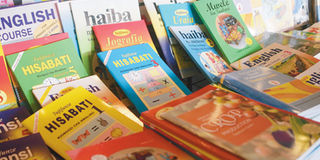Of textbooks, teacher guides in TZ schools

School books on display. PHOTO | FILE
What you need to know:
- Ten years later, I became a teacher. I taught physics and mathematics. There were a lot of problems to be solved. When I instructed a student to solve a question, I would later look for the answer in the teacher’s guidebook. This is the book that Mr Ajaib used.
Mr Ajaib Singh was our class and mathematics teacher. In those days, we had to do some mental arithmetic. Mr Ajaib would call up a student and throw a question from the textbook. What surprised me then was that whenever anybody answered, the teacher would look into his book, then shout, “Correct” or “Wrong”. I was surprised because I thought that since he was a trained maths teacher; shouldn’t he be able to do the calculations mentally? Why had he to refer to another book? I never asked. Unfortunately, I never met Mr Ajaib after finishing school.
Ten years later, I became a teacher. I taught physics and mathematics. There were a lot of problems to be solved. When I instructed a student to solve a question, I would later look for the answer in the teacher’s guidebook. This is the book that Mr Ajaib used.
A couple of years later, I was employed as an editor in a publishing house. Editing textbooks was an arduous task, still is. Again as an editor it was my duty to make sure that all the problems in the learner’s book had their correct answers in the teacher’s guide. This meant cross checking the answers in the teacher’s guide.
Editing textbooks was also tedious because at the page proof stage one had to make sure that all the references in the teacher’s guide corresponded to the exact page in the learner’s book.
The teachers’ guide provides answers, and is almost a minute-by-minute manual for teachers. The guides identify the aim of the lesson and gives advice on the teaching methodology. It recommends tours and visits. The teacher’s guide was something that no teacher would be without if he wanted to make sure learning takes place.
In the past, the government set aside funds for purchasing each published textbook and teacher’s guide book. The later were distributed to teacher training colleges (TTCs). Every teacher would know before graduation what she or he would teach and which books will be used in the teaching process.
Then one day the government decided not to buy textbooks and guides. This was a blunder.
Before the formation of the Eductional Materials Committee (Emac) in 1999, the Publishers Association of Tanzania (Pata) suggested that every Emac approval should be accompanied by a commitment to purchase. There were three advantages: First, TTCs would have all the textbooks used in schools. Secondly teacher resource centres would be supplied with all new approved textbooks and guides. Thus in-service teachers would get information of new books. Thirdly, the commitment to purchase would mean that Emac would work within a budget. They would not be able to approve too many books for the same subject and for the same class. Emac would have also profited from the criticism of the books from tutors and teachers before the books reached the classrooms. Unfortunately this request was not accepted.
In 2013, the open-ended approval system was tabled in Parliament. Politicians condemned Emac. The truth of the matter is that less than 5 per cent of books approved by Emac that contained errors were used to condemn Emac, leading to its scrapping. Three years later, an Emac was quietly born again in the Tanzania Institute of Education (TIE).
The Commissioner of Education produced Circular No 4 of August 2014, which gave responsibility to produce textbooks to TIE. It took TIE three years to produce poor quality textbooks unfit for human consumption. In May, 2017 Parliament was in uproar over the books. They were withdrawn. But TIE, did not produce even one teacher’s guide for all the textbooks!
We were told this February, that the textbooks have been revised and are being printed and will be delivered to schools. What will the teachers be teaching during the waiting period?
The new books also do not have the teacher’s guides, how will the teachers cope? I fear for my fellow mathematics teachers, as they will have to do the questions in the pupil’s books to obtain the answers, so that they can shout “Correct” of “Wrong” as my teacher Mr Ajaib Singh and myself used to do.



